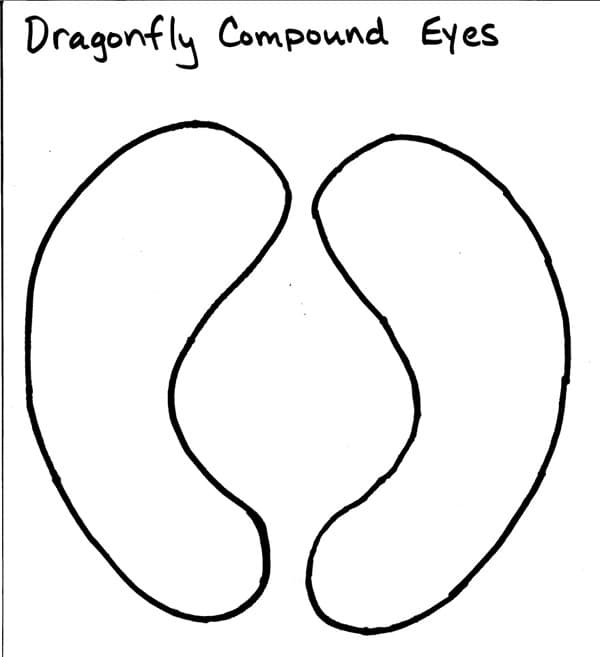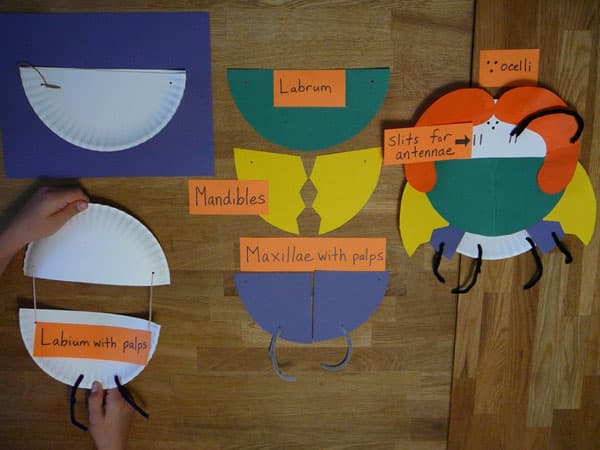Lesson One: Three Dimensional Movable Dragonfly Head Model
Question
What are the parts of the dragonfly's mouth and how do they work?
Objectives
The learner will build a three dimensional model of the dragonfly's mouth with the help of a partner.
Pre-teach Scissor Safety
Before beginning a project with scissors, remind students about scissor safety.
Materials
One 8 or 9 inch paper plate per student (thin inexpensive paper plates work well), 3 different colors of construction paper (this should be uniform for every student so that color can be used to refer to the structures of the mouth, as in the "yellow mandibles"), 2 brass brads per student, scissors, pencil, hole punchers, 4 pipe cleaners, glue and one compound eye template (See Figure 3) cut out of cardboard or stiff paper for each group of four students to share, or use Figure 1 and copy onto paper.
Figure 3
 " alt=""/>
" alt=""/>
Prepare the paper plates ahead of time with a pair of vertical cuts for each antennae using the brass brads and placing about a quarter from the top of the plate towards the middle and about 2 inches apart horizontally. See figure 4.
Figure 4
 " alt=""/>
" alt=""/>
Directions
1. Give each student a paper plate and give each pair of students three different colors of construction paper. Have students take turns using the paper plate as a template and tracing the circle on all three papers and set aside.
2. Fold the plate in half and then open and cut along the fold.
3. Take the two halves and place together and use a hole punch to make two holes on opposite ends of the half circles (total of four circles with doubled plates). The holes will be more uniform if students slide the hole-punch onto the paper plates till it stops, then punch. See figure
4. Cut open 2 rubber bands (or use thin elastic) and place through the holes. Leave slack in the rubber band. This is the model of the dragonfly's lower lip called the labium. It moves longitudinally and can move very quickly. Young nymph dragonflies catch their food with their labium.
5. The labium also has palps which are involved in taste. Add the palps by punching two holes and placing half a pipe cleaner in each one.
6. Have students take three papers and cut out the three circles. Fold the circles in half and cut each one. Each student should have 3 different colored half circles.
7. Have students punch holes on opposite sides of the paper half circles, just as they did with the plates.
8. Next, students will fold one of the colors in half (for two fourths) to create the maxillae (singular: maxilla). Place the maxillae on top of the lower lip. The maxillae move laterally, or sideways, and are the second pair of jaws. Once the mask is built, it will be easy for the students to see this as the second jaw.
9. Cut a pipe cleaner in half and attach to each maxilla by punching a hole. These are the palps and they are sensory organs that help the dragonfly taste and smell their food.
10. Now the students will form the first jaw by folding another half circle in half (two fourths) and this time making a jagged cut. These jaws are responsible for cutting, chewing, tearing and carrying food. They move laterally, like the maxillae.
11. Keep the last half circle intact and place on top of all mouthparts. This top covering is like the upper lip and it is called the labrum which moves longitudinally in an up and down motion. The labrum is useful for pulling food into its mouth. Use the two brads to attach the mouthparts to the top half of the plate through the same hole the rubber band is wrapped through. The bottom lip of the dragonfly should be able to move freely.
13. Now the students will add the large compound eyes of the dragonfly. Have students trace the compound eye template or cut out a copied set of compound eyes from Figure 1. Have them apply a small amount of glue only to the top part of the eye because you don't want glue on or near the mouthparts because you want them to be able to move freely.
14. Students will add three dots in the shape of an upside down triangle between the eyes near the top of the head to form the ocelli, which are 3 simple light receptive organs.
15. Form the antennae located between the eyes using two pipe cleaners. Feed a folded in half pipe cleaner through the two slits (part of preparation) and twist together. Do the same on the other side. See completed mask in Figure 2. The antennae have olfactory receptors which allow the dragonfly to smell its food.
Introduce the names of each structure while building each one, and save the labeling of the structures for another day. It is important that the focus of this first lesson be on the function of the mouthparts and not on the vocabulary. Briefly introduce each one and move onto the next structure. In Lesson Two, the teacher and students will construct a model of the housefly's mouth. These two models can then be used to compare the two insects feeding habits. Many insects share similar mouthparts as the dragonfly.
Independence
Allow students to construct the model with a buddy class and teach the other students what they've learned about the structures on the dragonfly's head and mouth.
Extension
Students will take the model home and teach family members or friends about the structures of the dragonfly's head. Students will write down questions from parents. These questions could lead to whole class investigations or independent student investigations.

Comments: